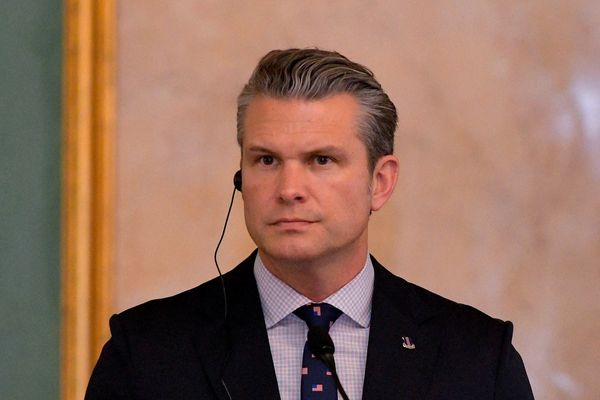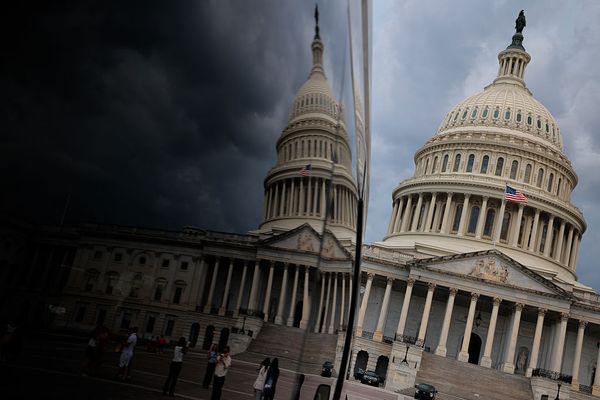
Voters in the Czech Republic go to the polls on 3 and 4 October in what protagonists and analysts describe as a pivotal parliamentary election that could lead to clashes with the EU on issues from migration to climate policy.
The vote will be keenly watched in Brussels, which is nervously considering the possibility of a third anti-EU agitator in central Europe alongside Hungary and Slovakia, with potential implications for the bloc’s support for Ukraine.
What’s the story and why does it matter?
He’s (almost) back. Four years after losing to an unwieldy coalition united against him, the billionaire former prime minister Andrej Babiš – the “Czech Trump” – and his Action of Dissatisfied Citizens party (ANO, or Yes in Czech) seem assured of first place.
The populist ANO, a member of Viktor Orbán’s nation-first Patriots for Europe group, is polling 10 points higher than the centre-right Spolu (Together) alliance led by the prime minister, Petr Fiala. It won European and regional elections in 2024 and is on track to score about 30%.
While no party is forecast to win a majority in the 200-seat lower house of parliament, ANO – assuming it does finish first – will begin coalition talks with a range of smaller parties to try to find the parliamentary backing it will need to form a cabinet.
It is not certain to succeed. But if it does, parties such as the anti-EU, pro-Russian Freedom and Direct Democracy (SPD) and Stačilo! or the upstart Motorists for Themselves would demand significant policy concessions in exchange for their votes.
Who are the players and what are they promising?
Babiš, 71, an agribusiness billionaire, started ANO as a centrist, pro-European movement in 2011 but has since turned it into a populist anti-immigration and EU-sceptical party. It has pledged to cap energy prices, lower the pension age and cut individual and corporate taxes.
Babiš has also promised to fight the EU’s green agenda and migration pact and said he is open to alliances with parties opposed to further aid to Ukraine. He wants to end the “Czech initiative” to supply western-funded artillery ammunition to Ukraine.
Fiala’s three-party Spolu alliance, which has cut the Czech public deficit from 5% to 2% since it took over from Babiš in 2021, says ANO’s pledges would send the country into a debt spiral. It is promising to restore public finances, reduce debt and upgrade the armed forces.
The Mayors and Independents (Stan) party, a liberal, centrist, pro-EU party and member of Fiala’s outgoing, pro-austerity government coalition, wants the Czech Republic to adopt the euro, as does the liberal, centrist Pirates party, part of the government until last year.
On the far left, the Moscow-friendly, anti-establishment Stačilo! (Enough!) alliance, including the once-mighty Social Democrats and central Europe’s last unreformed Communist party, is promising referendums on leaving the EU and Nato and the nationalisation of key industries.
On the far right, SPD, which has swallowed three smaller radical right parties, is anti-EU, anti-Nato, anti-immigration and anti-aid to Ukraine. Motoristé sobě (Motorists for Themselves) rejects green policies and wants the cost of living reduced.
What are the big issues?
High inflation and a severe cost of living crisis have helped fuel deep discontent with Fiala: only 15% of Czechs say they are satisfied with the country’s political situation. A poll last year showed fewer than half felt better off than before the 1989 Velvet Revolution, when anti-government protesters toppled the communist regime in what was then Czechoslovakia.
Energy costs and security remain major concerns but most analysts suggest many people will vote with their wallets. The government is widely seen as out of touch with its public and more interested in boosting politicians’ incomes than keeping prices down.
Fiala’s attempts to limit the damage have so far mostly been confined to reminding voters of the threat an ANO-led coalition would represent to Czech democracy, the rule of law and the country’s continued alignment with the pro-European mainstream.
How does the system work?
Seats in parliament are allocated in each constituency on a proportional basis, with single parties having to clear an electoral threshold of 5% of the national vote, two-party alliances needing 8% and groups of three or more 11%.
A total of 28 parties have registered to take part in the elections. Unusually, voting in the Czech Republic takes place over two days – Friday and Saturday morning – and almost complete results can be expected by late on Saturday afternoon.
What do the polls suggest and what might the results produce?
ANO is polling at just above 30%, with the governing centre-right Spolu alliance on 21% and the far-right SPD on 12%. The pro-EU Stan and the Pirates are on 11% and 9% respectively, the far-left Stačilo! is on 7% and the radical right Motorists for Themselves are on just over 5%.
ANO won more seats than any other party in the October 2021 parliamentary elections but narrowly lost the popular vote and was squeezed out by the opposition parties. The three Spolu parties, plus Stan and the Pirates, have all said they will not work with ANO, Stačilo! or SPD this time either.
Complicating matters further, the Czech president, Petr Pavel, has said he reserves the right to refuse to appoint ministers who advocate leaving the EU or Nato, nor will he appoint far-left or far-right MPs to cabinet posts involving security or foreign affairs.
Analysts have said the Spolu-Stan-Pirates coalition could be re-formed if the parties involved win enough seats. A formal ANO-led coalition could be much harder to form and sustain, however, since it would have to include the far right, the far left – or perhaps both.
It is unclear what concessions Babiš might be willing to make to confidence-and-supply or coalition partners. He is thought to favour a single-party minority ANO government backed in parliament by Stačilo!, SPD or both, plus – if they clear 5% – the Motorists.
None of the possible outcomes involving ANO look particularly stable.







